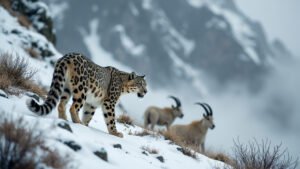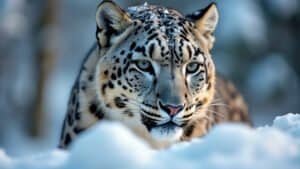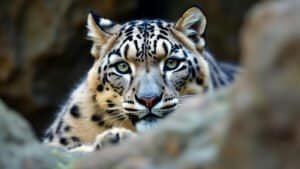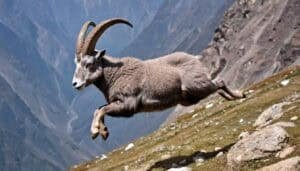Introduction
Snow leopards, the elusive big cats of the mountains, have diets that vary significantly depending on their region. This article delves into the differences in their primary prey species, comparing the blue sheep in the Himalayas to the ibex in the Altai Mountains
We’ll explore how prey availability and habitat influence their dietary habits, including the seasonal and human impacts. Additionally, we will examine the adaptations snow leopards have made to hunt different prey, and how their diet affects their health and reproduction
Finally, we’ll discuss the conservation implications of these dietary differences and the strategies needed to protect these majestic predators
Differences in Primary Prey Species
Snow leopards are apex predators whose diet is primarily influenced by the availability of prey in their respective habitats. Understanding the differences in primary prey species across regions is crucial for comprehending their hunting behaviors and ecological roles
Himalayan Prey: Blue Sheep and More
In the high-altitude regions of the Himalayas, the diet of snow leopards primarily consists of blue sheep (Pseudois nayaur), also known as bharal
Blue sheep are well-adapted to the rugged, rocky terrain and high altitudes, making them a staple in the diet of Himalayan snow leopards. These herbivores weigh between 77 to 165 pounds and are a reliable source of food throughout the year
In addition to blue sheep, Himalayan snow leopards also prey on Himalayan tahr (Hemitragus jemlahicus), argali sheep (Ovis ammon), and domestic livestock such as goats and sheep, especially in areas where wild prey is scarce due to human encroachment or habitat loss
The predation on livestock often leads to human-wildlife conflicts, impacting conservation efforts
Altai Mountains Prey: Ibex and Alternatives
In the Altai Mountains, located across Russia, China, Mongolia, and Kazakhstan, snow leopards primarily prey on Siberian ibex (Capra sibirica)
The Siberian ibex, weighing between 88 to 220 pounds, is adapted to the steep, rocky slopes of the Altai region. These ungulates are highly agile and provide a challenging hunt for snow leopards
Other significant prey species in the Altai Mountains include argali sheep, marmots, and smaller mammals such as hares and birds. Like their Himalayan counterparts, snow leopards in the Altai also occasionally hunt domestic livestock, leading to similar conflicts with local herders
Impact of Prey Species on Snow Leopard Behavior
The type of prey available in different regions significantly impacts snow leopard behavior. In the Himalayas, where blue sheep are abundant, snow leopards tend to have larger territories and exhibit more solitary behaviors due to the dispersed nature of their prey
In contrast, the hunting of ibex in the Altai Mountains often requires more strategic stalking and ambush techniques due to the ibex’s agility and the challenging terrain
Prey Availability and Habitat Influence
The availability of prey and the characteristics of the habitat significantly influence the diet and behavior of snow leopards. These factors vary greatly between regions, impacting their hunting strategies, territorial range, and survival
Comparison of Himalayan and Altai Habitats
The Himalayan region is characterized by its high altitudes, steep cliffs, and rugged terrain. These areas, often above 9,800 feet, provide a unique environment where blue sheep, Himalayan tahr, and other herbivores thrive
The diverse terrain of the Himalayas, with its mix of rocky outcrops and alpine meadows, supports a variety of prey species, allowing snow leopards to adopt a versatile hunting strategy
In contrast, the Altai Mountains feature a mix of high-altitude plateaus, forested valleys, and steep rocky slopes. The region’s lower altitudes, compared to the Himalayas, support a different composition of prey species, primarily Siberian ibex and argali sheep
The varied landscape of the Altai Mountains requires snow leopards to be highly adaptable, utilizing different hunting techniques to capture their prey
Seasonal Changes in Prey Availability
Seasonal changes play a crucial role in prey availability for snow leopards. In the Himalayas, the harsh winter months can drive prey species to lower altitudes, where vegetation is more accessible
This seasonal migration of prey forces snow leopards to adjust their hunting grounds and strategies. During summer, the prey returns to higher altitudes, requiring snow leopards to follow and adapt to the changing environment
In the Altai Mountains, seasonal variations similarly affect prey distribution. Winter snows can make it difficult for snow leopards to access higher elevations, pushing both predator and prey to lower altitudes
This seasonal movement influences the diet of snow leopards, as they might rely more on smaller mammals and livestock during the winter months when ibex and argali are less accessible
Human Impact on Prey and Habitat
Human activities significantly impact prey availability and habitat quality in both the Himalayas and the Altai Mountains. In the Himalayas, livestock grazing, agricultural expansion, and infrastructure development reduce the natural habitats of blue sheep and other wild prey
These activities not only decrease prey populations but also lead to more frequent human-snow leopard conflicts, as the predators turn to livestock as an alternative food source
Similarly, in the Altai Mountains, mining, logging, and poaching have detrimental effects on the habitat and prey species. The decline in wild prey due to these activities forces snow leopards to venture closer to human settlements, increasing the risk of retaliatory killings by local herders
Conservation efforts in both regions aim to mitigate these impacts by protecting key habitats, enforcing anti-poaching laws, and promoting coexistence strategies between humans and snow leopards
Adaptations to Regional Diets
Snow leopards exhibit various adaptations that enable them to hunt and thrive in the diverse environments of their respective regions. These adaptations include changes in hunting techniques, physical characteristics, and behaviors suited to their primary prey and habitat conditions
Hunting Techniques for Different Prey
In the Himalayas, snow leopards rely on ambush and stealth to hunt blue sheep and Himalayan tahr
The rugged terrain provides ample cover for stalking, allowing them to approach their prey undetected before making a swift attack. Their powerful hind legs enable them to leap across rocky surfaces and steep cliffs, closing the distance to their prey quickly
In the Altai Mountains, hunting techniques vary slightly due to the different prey species and terrain. When hunting Siberian ibex, snow leopards use a combination of stealth and endurance
The ibex are highly agile and can navigate steep, rocky slopes with ease, making them challenging targets. Snow leopards in this region often employ patience and strategic positioning, waiting for the right moment to strike from a concealed vantage point
Physical Adaptations
Snow leopards have several physical adaptations that support their hunting capabilities and dietary needs. Their thick fur provides insulation against the cold temperatures of their mountainous habitats, while their large nasal cavities warm the cold air before it reaches their lungs
This adaptation is crucial for surviving in high-altitude regions where temperatures can drop significantly
Additionally, snow leopards have large, powerful paws that act like natural snowshoes, distributing their weight evenly and allowing them to move silently and swiftly over snow-covered terrain. Their long, muscular tails aid in balance and agility, particularly when navigating steep and uneven surfaces during a hunt
Behavioral Changes
Behaviorally, snow leopards exhibit remarkable adaptability to their regional diets
In regions where prey is abundant, such as areas with high populations of blue sheep in the Himalayas, snow leopards tend to have smaller home ranges and are more territorial. This behavior ensures they have consistent access to food sources and can effectively raise their cubs
In contrast, in areas with lower prey density or higher human disturbance, such as parts of the Altai Mountains, snow leopards may have larger home ranges and more nomadic behaviors. They cover vast distances in search of food, which requires significant energy expenditure and adaptation to varying prey availability
Health and Reproduction Impacts
The diet of snow leopards significantly influences their overall health, reproductive success, and ability to thrive in their harsh environments
Understanding these impacts can shed light on the broader ecological role of these predators and the importance of maintaining their natural food sources
Nutritional Needs and Prey Quality
Snow leopards require a high-protein diet to maintain their muscle mass, energy levels, and overall health. The quality and availability of prey directly affect their nutritional intake
In the Himalayas, blue sheep and Himalayan tahr provide a rich source of protein and essential nutrients. These prey species are relatively large, which means a single successful hunt can sustain a snow leopard for several days
In the Altai Mountains, Siberian ibex and argali sheep similarly fulfill the nutritional requirements of snow leopards. However, the smaller mammals and birds they occasionally prey on may not provide the same level of nutrition, necessitating more frequent hunts to meet their dietary needs
The health of snow leopards can be compromised if their diet lacks the necessary nutrients, leading to weakened immune systems and lower reproductive success
Reproductive Success and Diet
The reproductive success of snow leopards is closely linked to the availability of high-quality prey
Adequate nutrition is crucial for females during pregnancy and lactation, as it directly affects the health and survival of their cubs. In regions with abundant prey, such as parts of the Himalayas, snow leopard females are more likely to have higher reproductive success due to consistent access to nutritious food
Conversely, in areas where prey is scarce or human activities have reduced prey populations, reproductive success can be compromised. Inadequate nutrition can lead to lower birth weights, reduced milk production, and higher cub mortality rates
These factors can significantly impact the population dynamics of snow leopards, making conservation efforts to preserve their natural prey critical for their long-term survival
Health Issues Related to Diet
A poor diet can lead to various health issues in snow leopards, including malnutrition, weakened immune systems, and increased susceptibility to diseases
In regions where human encroachment has reduced wild prey populations, snow leopards may resort to hunting livestock, which can lead to nutritional deficiencies if domestic animals do not provide the same nutrients as wild prey
Furthermore, the stress of living in areas with high human activity can exacerbate health problems, as constant disturbances can disrupt hunting and feeding behaviors. This stress can lead to decreased physical condition and lower reproductive rates, ultimately affecting the overall health and sustainability of snow leopard populations
Conservation Implications
The dietary differences of snow leopards in various regions have significant conservation implications. Understanding these differences helps in designing effective strategies to protect these majestic predators and their habitats
Regional Conservation Strategies
Conservation strategies need to be tailored to the specific dietary needs and ecological roles of snow leopards in different regions
In the Himalayas, efforts focus on protecting the primary prey species, such as blue sheep and Himalayan tahr, by maintaining healthy populations through habitat preservation and anti-poaching measures
Additionally, community-based conservation programs aim to reduce human-wildlife conflict by promoting coexistence and providing incentives for local communities to protect snow leopards and their prey
In the Altai Mountains, conservation strategies also emphasize habitat protection and prey population management. Efforts include creating protected areas, implementing sustainable land-use practices, and engaging local communities in conservation activities
Addressing illegal hunting and poaching of both snow leopards and their prey is a critical component of these strategies, ensuring that snow leopards have adequate food resources
Addressing Human-Wildlife Conflict
Human-wildlife conflict poses a significant threat to snow leopards, especially when they prey on livestock
In both the Himalayas and the Altai Mountains, initiatives to mitigate conflict include improving livestock management practices, such as building predator-proof corrals and using guard animals to protect herds
Compensation programs for livestock losses and community-based insurance schemes help reduce retaliatory killings of snow leopards by providing financial support to affected herders
Education and awareness programs are crucial in fostering positive attitudes towards snow leopard conservation. By involving local communities in monitoring and conservation efforts, these programs build a sense of stewardship and highlight the ecological and cultural importance of snow leopards
Protecting Key Prey Species
The conservation of snow leopards is closely tied to the protection of their prey species. Ensuring healthy populations of blue sheep, Himalayan tahr, Siberian ibex, and argali sheep is essential for maintaining the natural balance in their habitats. Conservation programs focus on monitoring prey populations, protecting critical habitats from human disturbance, and restoring degraded areas
Collaborative efforts between governments, non-governmental organizations, and local communities are vital in achieving these goals
By addressing habitat fragmentation, implementing sustainable land-use practices, and enforcing anti-poaching laws, these initiatives aim to create a sustainable environment where both snow leopards and their prey can thrive
Methods to Study Snow Leopard Diet
Understanding the diet of snow leopards is crucial for conservation efforts. Researchers employ various methods to study their dietary habits and gather data that informs effective conservation strategies
Scat Analysis
Scat analysis, or the study of feces, is one of the primary methods used to understand the diet of snow leopards
By collecting and analyzing scat samples, researchers can identify the remains of prey species through DNA analysis, hair identification, and bone fragments. This non-invasive method provides valuable insights into the dietary habits of snow leopards without disturbing their natural behavior
Advancements in genetic techniques have improved the accuracy of scat analysis, allowing researchers to identify not only the prey species but also individual snow leopards based on their DNA. This information helps in understanding the feeding patterns, prey preferences, and health of individual snow leopards
Camera Traps and Direct Observation
Camera traps are widely used to monitor snow leopard populations and their hunting behavior
These motion-activated cameras capture images and videos of snow leopards in their natural habitat, providing direct evidence of their prey species and hunting techniques. Camera traps are especially useful in remote and rugged terrains where direct observation is challenging
Direct observation, although less common due to the elusive nature of snow leopards, involves tracking and observing these predators in the wild
Researchers use binoculars and spotting scopes to watch snow leopards from a distance, recording their hunting behavior, prey selection, and feeding patterns. This method provides detailed behavioral data but requires significant time and effort
GPS and Radio Collaring
GPS and radio collaring involve fitting snow leopards with collars that transmit location data, allowing researchers to track their movements and study their home ranges
By analyzing the movement patterns, researchers can identify kill sites and investigate what prey species are being consumed. This method provides comprehensive data on the spatial ecology and diet of snow leopards
The use of collars also helps in understanding the impact of seasonal changes, human activities, and habitat fragmentation on the feeding behavior of snow leopards. However, collaring requires capturing and handling the animals, which involves certain risks and ethical considerations
Stable Isotope Analysis
Stable isotope analysis is a scientific technique used to study the diet of snow leopards by examining the chemical composition of their tissues, such as hair, blood, and bones
Isotopes are naturally occurring forms of elements that vary based on the diet and environment of an organism. By analyzing these isotopes, researchers can infer the types of prey consumed and the proportion of different prey species in the diet
This method provides long-term dietary data and can reveal changes in diet over time. Stable isotope analysis is particularly useful in understanding the ecological roles of snow leopards and their interactions with other species in their habitat
Conclusion
The dietary habits of snow leopards vary significantly across different regions, influenced by prey availability, habitat, and human activities. In the Himalayas, their diet primarily consists of blue sheep and Himalayan tahr, while in the Altai Mountains, Siberian ibex and argali sheep are the main prey
These dietary preferences impact snow leopard behavior, health, and reproductive success, underscoring the importance of region-specific conservation strategies. Understanding these differences through methods like scat analysis, camera traps, and GPS collaring is crucial for effective conservation efforts
Protecting key prey species and mitigating human-wildlife conflict are essential for ensuring the survival of these elusive big cats. Tailored conservation initiatives that address the unique challenges of each region are vital for maintaining healthy snow leopard populations and preserving their natural habitats
By focusing on habitat preservation, prey management, and community involvement, we can support the long-term survival of snow leopards and their critical role in the mountain ecosystems













